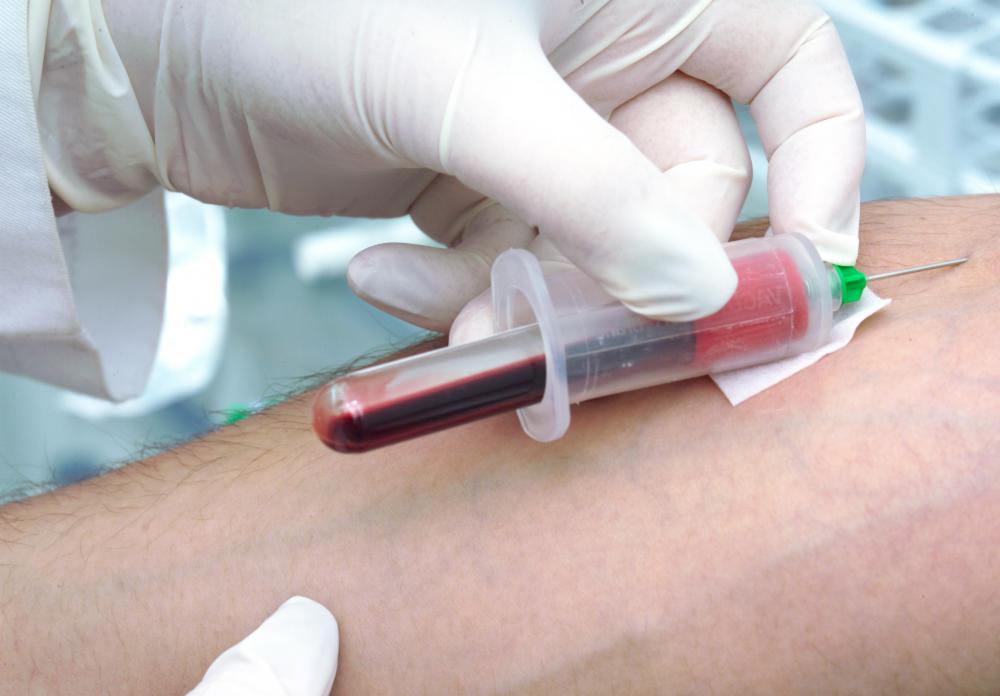At TheHealthBoard, we're committed to delivering accurate, trustworthy information. Our expert-authored content is rigorously fact-checked and sourced from credible authorities. Discover how we uphold the highest standards in providing you with reliable knowledge.
What are Lactic Acidosis Symptoms?
Lactic acidosis occurs when lactic acid accumulates in the blood more quickly than it is removed. Common lactic acidosis symptoms include clamminess, fatigue, stomachache, lethargy, rapid heartbeat, rapid breathing, sweet-smelling breath and nausea. It can feel similar to heat stroke or heat exhaustion, and it most often arises in situations where those conditions are likely to occur.
A blood test can determine whether too much lactic acid is in the blood. Further testing might be needed to figure out the cause, though. It might be necessary to test spinal fluid to rule out certain life-threatening infections.

Lactic acidosis symptoms are similar to many of the symptoms of overheating and exhaustion, so a person might mistake his or her symptoms for one another. Intense exercise is the most common cause behind the condition. The cure often is as simple as resting until the body can break down the excess of lactic acid in the blood. Drinking sports drinks containing electrolytes helps prevent the problem or can speed up recovery.

When the kidneys or liver aren't functioning properly, waiting for the body to recover by itself might not be possible. Diabetes patients, people suffering from acquired immunodeficiency syndrome (AIDS) and other auto-immune disorders and those with liver and kidney problems might be at increased risk and should take lactic acidosis symptoms seriously. Left untreated, the condition eventually can lead to a coma.

There are a variety of medications and poisons that also can lead to the buildup of lactic acid. The problem with poisons, of course, is that most often, resulting illnesses are from accidental exposure. It can be difficult to pinpoint the source. When medications are the culprit, it might be a matter of time before suitable replacements can be found. In those cases, it is best to work closely with a doctor who takes care to monitor the person's progress.

Sometimes it is the lack of something causing a problem. Along with lactic acidosis symptoms, patients with a deficiency in Vitamin B1, for instance, can experience memory loss, depression and general confusion. A trained medical professional will be able to determine the source of the problems and any treatment that is necessary.
This condition is not always for the worst. High-performance athletes often learn to work through the symptoms of sore, fatigued muscles to reach new plateaus. Recent research suggests that the buildup of lactic acid in these cases might enhance abilities, pushing the human body further than it normally would go. Before attempting to use lactic acid in this way, however, more research and supervision by a knowledgeable professional should be employed.
AS FEATURED ON:
AS FEATURED ON:

















Discussion Comments
Eating bananas is a good way to prevent lactic acid build up. Actually, bananas are a great food that helps cope with several of the nagging side effects of regular exercise, including cramping and dehydration.
Coaches, trainers and gym teachers have always told me to warm up before I started any type of exercises. When I was young and limber I didn't pay much attention to this advice because I didn't worry about pulling muscles or any of those other injuries you might get from not warming up enough.
However, what I didn't know back then is that stretching and slowly easing into exercise also helps reduce the amount of lactic acid you produce. If you have a problem with chronic acidosis after you exercise then warming up for ten or fifteen minutes might be enough to help you curb some of the lactic acidosis symptoms.
I have played sports since I was old enough to walk, so physical activity is something my body is accustomed to. This is why I was surprised when I learned that the weight lifting I was doing to build muscle and add body weight was causing my body to build up more lactic acid than I was able to flush out of my body naturally.
Normally, exercise gives me energy, but after my heavy weight lifting sessions, I was so tired that all I wanted to do was lie on the sofa and take a nap. My muscles were also very sore 24 to 36 hours after I worked out. I thought this would go away after my body built up to the new workouts, but it didn't. As it turns out, I was experiencing lactic acidosis symptoms.
Now that I know what is causing the soreness and the lack of energy after workouts, I am making a point of drinking a lot more water during the workouts. After each set of exercises, I make sure to drink a little water. Then I also drink water throughout the day to flush out the lactic acid via my kidneys.
Post your comments